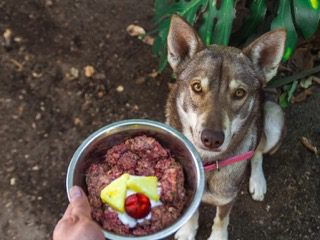Yes, dogs can eat raw meat. Feeding dogs a raw diet, also known as a "raw food diet" or "BARF diet" (Biologically Appropriate Raw Food), has become increasingly popular among dog owners. However, it's important to understand the considerations and precautions involved when feeding dogs raw meat.
- Consult a veterinarian: Before transitioning your dog to a raw meat diet, it's crucial to consult with a veterinarian who can provide guidance based on your dog's specific needs, health conditions, and any dietary restrictions.
- Research and planning: Educate yourself about the nutritional requirements of dogs and the appropriate balance of nutrients in their diet. The raw meat diet should consist of a variety of animal protein sources, including muscle meat, organ meat (such as liver and kidney), and raw meaty bones. You may also need to include other ingredients like vegetables, fruits, and supplements to ensure a complete and balanced diet.
- Quality and sourcing: Choose high-quality, human-grade meat from reliable sources. Look for meat that is fresh, free from additives, and ideally, organic or grass-fed. Raw meat should be handled and stored properly to minimize the risk of bacterial contamination.
- Gradual transition: If your dog is currently on a different type of diet, it's best to introduce raw meat gradually. Start by replacing a small portion of their regular food with a small amount of raw meat and gradually increase the ratio over time. This helps your dog's digestive system adjust to the new diet and reduces the chances of stomach upset.
- Monitor your dog's health: Keep a close eye on your dog's overall health, including their coat condition, energy levels, and stool consistency. If you notice any negative changes, consult your veterinarian to ensure your dog's nutritional needs are being met.
- Hygiene and safety: When handling raw meat, maintain good hygiene practices to prevent the spread of bacteria. Clean your hands, utensils, and feeding bowls thoroughly after handling raw meat. Also, be cautious about leaving raw meat out for extended periods to avoid spoilage.
- Considerations for specific breeds: Some breeds may have specific dietary requirements or sensitivities, so it's important to consider these factors when feeding raw meat. For example, large-breed dogs may require additional bone content in their diet to maintain proper calcium and phosphorus levels.
- Regular veterinary check-ups: Schedule regular veterinary check-ups to monitor your dog's overall health and ensure that the raw meat diet is meeting their nutritional needs. Blood tests may be necessary to check for any deficiencies or imbalances.
- Research potential risks: While raw meat can be a beneficial diet for many dogs, there are risks associated with bacterial contamination, such as Salmonella or E. coli. Understand these risks and take appropriate precautions to minimize themRemember, the decision to feed your dog a raw meat diet should be made after careful consideration, consultation with a veterinarian, and thorough research. Each dog is unique, and what works for one may not work for another. By taking the necessary precautions and monitoring your dog's health, you can provide them with a balanced and nutritionally appropriate raw meat diet.
